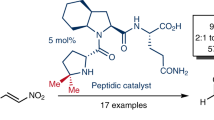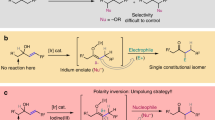Abstract
The synthesis of complex natural products still remains as the bottleneck for the biological evaluation of such compounds. In contrast to the biosyntheses, vinylogous aldol reactions can incorporate more than one acetate or propionate building block into the growing polyketide chain. To facilitate such reactions either enolate activation or aldehyde activation is required. For both variations, selective protocols have been put forward and were shown to be efficient substitutes compared to standard aldol reactions. As can be seen in the total syntheses of natural products such as callipeltoside, their use shortens the synthetic route significantly. One of the most challenging transformations in this context is the use of γ-substituted ketene acetals in both aldehyde and enolate activation. In particular, aliphatic aldehydes give poor yields and selectivities. Protocols for the enantioselective variation are given using either the Tol-BINAP system or C2-symmetrical copper(II) complexes.

Preview
Unable to display preview. Download preview PDF.
Similar content being viewed by others
Author information
Authors and Affiliations
Corresponding author
Editor information
Rights and permissions
About this chapter
Cite this chapter
Kalesse, M. Recent Advances in Vinylogous Aldol Reactions and Their Applications in the Syntheses of Natural Products. In: Mulzer, J. (eds) Natural Products Synthesis II. Topics in Current Chemistry, vol 244. Springer, Berlin, Heidelberg. https://doi.org/10.1007/b96887
Download citation
DOI: https://doi.org/10.1007/b96887
Published:
Publisher Name: Springer, Berlin, Heidelberg
Print ISBN: 978-3-540-21124-2
Online ISBN: 978-3-540-31475-2
eBook Packages: Chemistry and Materials ScienceChemistry and Material Science (R0)




